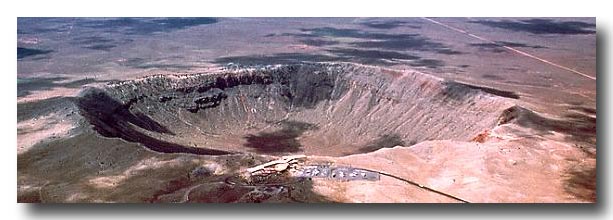



|

|

|
| Next Lecture | Last Lecture | UWS | Physics Dept |
There is an area in the solar system where asteroids are rather
common. Between Mars and Jupiter there is a belt of asteroids.
This Asteroid belt is about 1.5 A.U. wide and lies between 2.0 and 3.5
A.U. from the sun. Some of the asteroids are rather large, for example
Pallas-600km across, Cerres 900km. There are many such asteroids - about
100,000 can be seen using photographic plates. Many of the orbits are
eccentric. For example icarus's orbit brings it well within that of
Mars.

These asteriods are responsible for most of the craters and impact sites we see around the inner planets. Sometimes these hit earth. We looked at slides of Barringer crater in Arizona USA where 50,000 yrs ago a 50m across meteorite landed and created a crater 1.2km across. ( website ) An impact with a large meteorite or comet is one possible explaination for the demise of the dinosaurs. ( possible site underneath Yucatan )
Comets also might impact on Planets - Comet Shoemaker-Levy impacted upon Jupiter in 1994. (Since Jupiter is by far the largest planet its gravitional effect is much more than other planets) Images of this include images of the disintegratinging comet and images of the ``bruised'' jupiter - one , two and three
Comets might also pose a significant threat to Earth. The tunguska event in 1908 was probably a comet impacting in Siberia ( photo of fallen trees )
On 12 November 2014, ESA's Rosetta mission soft-landed its Philae probe on comet 67P/Churyumov-Gerasimenko. Data is still being analyed to test various hypothesis such as that the chemical building blocks of life originated in Comets.
© Dave Dunbar 2020